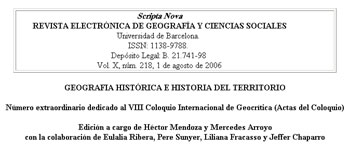The founding of cities and Spanish urban development thought in the Age of Discovery
Keywords:
cities founded by the Spanish, humanistic culture, millenarianismAbstract
Urban history referring to the historical period around 1492 and its parallels, from the fall of Constantinople (1452) and its development until the enthronement and settlement of the monarchy of Emperor Charles (~1530), is an exceptional period that requires interpretation in the light of new interdisciplinary approaches and new scientific discoveries. This period has generally been interpreted as the development of formulas, techniques and medieval examples, although it is also defined by several phenomena, some of which are fully Renaissant: 1) the spirit of the account of the Apocalypse and its descriptions of Heavenly Jerusalem; 2) the new definition of world history which, after the campaigns against Islam in Spain and the geographical discoveries of the New World, was based on both the Franciscan prophecy and on the millenarianist ecclesiastical school of thought; 3) the value acquired by the city in the light of the published works of classical philosophers, recovered thanks to Greek monks and learned men who fled to Italy from the Bosphorous and eastern Mediterranean. The experience that unfolded in the Iberian Peninsula took on a new meaning in a brief period, marked by a series of highly significant events: first, the campaigns in Baja Andalusia, the Canary Islands of Gran Canaria, La Palma and Tenerife, and on the African coast (14871498); second, the consolidation of the project for a city that complied with the Christian utopia (14991504), whose main representation was the city of Granada transformed by Christianity as Valencia was by Eiximenis; and third, the successive foundations designed for the areas of discovery and conquest (15051530), marked during this period by several experiments. The most noteworthy, for their significance as end of an era and beginning of the last world era, respectively: Santa Fe (province of Granada), a city that symbolises spiritual conquest, and San Cristóbal de La Laguna (Tenerife), a city of peace and a model for Christian colonisation based on utopian assumptions inspired by Greek philosophy—an experiment in 1500. The publication of books such as the Liber Chronicarum Etates Mundi by Hartman Schedel reveals this concept inspired by the Apocalypse, which describes the seven ages of the world through the birth and disappearance of cities, and always chooses an image and a description of a city as the central theme of the discourse.Downloads
Published
2007-05-03
Issue
Section
Articles
License
Los autores que publican en esta revista están de acuerdo con los siguientes términos:
- Los autores conservan los derechos de autoría y otorgan a la revista el derecho de primera publicación, cin la obra disponible simultáneamente bajo una Licéncia de Atribución Compartir igual de Creative Commons que permite compartir la obra con terceros, siempre que estos reconozcan la autoría y la publicación inicial en esta revista.
- Los autores son libres de realizar acuerdos contractuales adicionales independientes para la distribución no exclusiva de la versió de la obra publicada en la revista (com por ejemplo la publicación en un repositorio institucional o en un libro), siempre que se reconozca la publicación inicial en esta revista.





